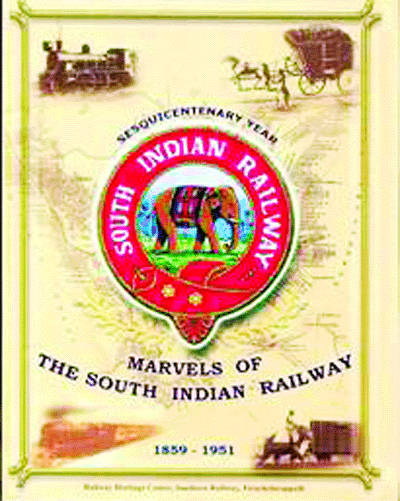MARVElS OF THE SOUTH INDIAN RAIlWAY
Author : S Subramhanyan
Publisher : Railway Heritage Centre, Rs 900
The book is a must-read for those interested in knowing the vintage days of Indian Railways, says Kumar Chellappan
The history of modern India can never be written without mentioning the role of the Indian Railways. The British colonial masters built the railway system in India to sustain and increase their hold over the subcontinent. But over a period of time, it played a crucial role in the country’s freedom struggle.
Since April 16, 1853 when the first ever locomotive chugged out of Bombay on its journey to Thane, the Indian Railways has undergone myriad changes with far-reaching reverberations. Today, it is one of the largest railway networks in the world. Though recent times have seen the image of the railways taking a beat, the institution has a rich heritage.
Equally interesting is the history of the evolution of the railway system. Every passenger, including the seasoned ones for whom train journey is a routine affair, has a passion to know more about the Indian Railways. It is for them the Railway Heritage Centre, Tiruchchirappalli, has come out with Marvels of South Indian Railway, in connection with the sesquicentenary year of the South Indian Railway. The Royapuram-Walajabad service in Madras (present day Chennai), the first railway service in south India, was launched on July 1, 1856. Soon railway lines connected major towns and cities in the south and distance between all south Indian States got shrunk!
The history of the South Indian Railways is not just a chronicle of land acquisition and construction works. It is also about stories, anecdotes and hard work of hundreds of engineers, technicians and artisans. S Subramhanyan, Divisional Railway Manager, Tiruchchirappallai, has come out with a coffee table book on the history of the South Indian Railways with special focus on Tamil Nadu.
Though conceived and produced as a coffee table book, Marvels of South Indian Railway is a must-read for those interested in knowing the vintage days of the Indian Railways. The present generation may not have heard how the railway network connecting Kerala, Tamil Nadu, Karnataka and Andhra Pradesh was built. It was no child’s play. A trip in the Punalur-Senkottai stretch is an exhilarating experience thanks to the enchanting beauty of the landscapes on either side of the route.
How many of us know that the present day South Indian Railways is an offshoot of the Great Southern of India Railway CompanyIJ The first ever train service in this region began on July 15, 1861, with the opening of Nagapattinam to Thiruvallur stretch. The service was extended to Thanjavur by December 1861 and since then there was no looking back.
Initially, various stretches of the railways functioned as different companies. Subramhanyan has given a vivid account of the integration of various companies into a single monolithic entity — the Indian Railways. As mentioned earlier, the evolution of the Indian Railways is filled with exciting incidents like the conversion of the Erode-Tiruchirapalli sector from Meter Gauge to Broad Gauge at an unbelievable speed. The 87.25-mile-long Erode-Tiruchirapalli track was converted from Meter Gauge to Broad Gauge in just five hours. Subramhanyan’s account of this unsung saga is exciting, entertaining and exhilarating.
“The last Meter Gauge train left Erode junction at 6.20 am on 25th September 1929 and immediately after it had passed each station, the specially selected staff with adequate labour force were utilised to remove the MG line and install Broad Gauge track including installation of the BG points and crossings and sidings. The strategy was to lay a third rail throughout the section leaving gaps only where it was necessary to retain points and crossings for the passage of the MG train without interruption… The first Broad Gauge train started punctually at 8.20 am from Erode Junction to Tiruchirapalli and was provided with necessary equipment and staff to meet any unexpected difficulties. The train was preceded by a Motor Trolly. The BG train arrived at Tiruchirapalli just after five hours of the last MG train on the same day,” writes Subramhanyan.
The author has also portrayed the reverence the English masters of colonial India had for Ram Setu, the stone structure between India and Sri lanka, which Hindus believe was built by lord Ram and his “monkey” brigade in their fight against Ravan who kidnapped Sita to the island nation. While the modern day rationalist Muthuvel Karunanidhi of the DMK is bent upon demolishing the Ram Setu for bringing prosperity to his future generation (please don’t ask him how), the Englishmen got a unique casket made in london by the Goldsmiths & Silversmiths Company for presenting to lord Pentland who visited Dhanushkodi on February 24, 1914.
The Gen-Next may not be aware of the fact that there was a Boat Mail plying between Madras Egmore and Talaimannar in Sri lanka. Equally interesting is how the Scherzer Rolling lift Bridge described as an engineering feat par excellence, was built connecting Rameshwaram to mainland India.
It is sad that we are very poor in documenting the marvellous feats perfected by our predecessors. When one watches the stories of engineering and construction marvels from the US and Europe beamed by television channels like National Geographic and Discovery, we feel sad. Our feats, too, should have been there. The Konkan Railway, the Sutlej-Beas link canal, the Delhi Metro, the Super National Highway connecting Kashmir to Kanyakumari... all qualify to be there at the centre-stage of the world. What we need are people like Subramhanyan who can make things happen. Either through books or documentaries.



























